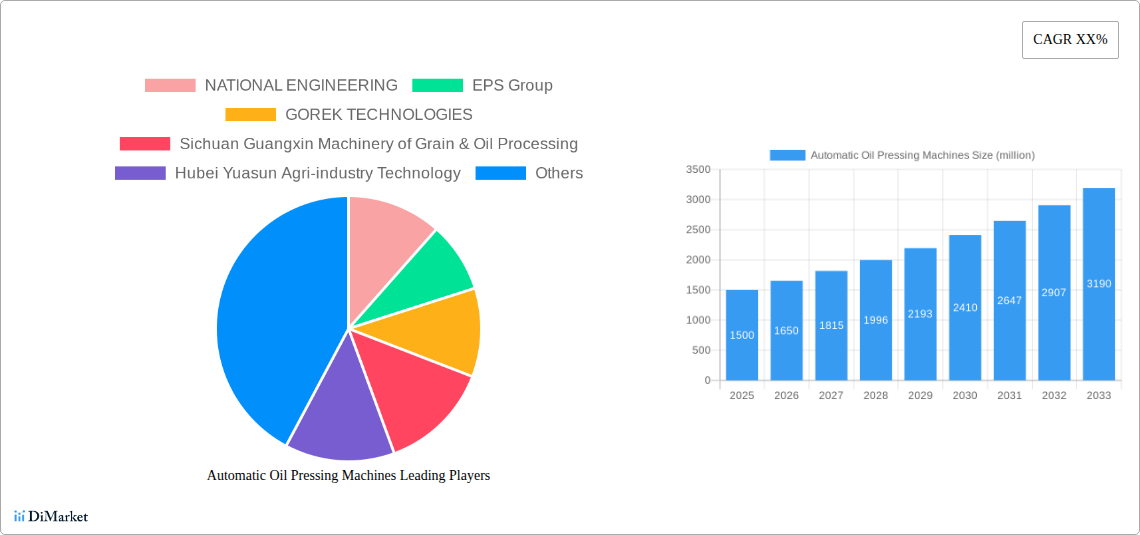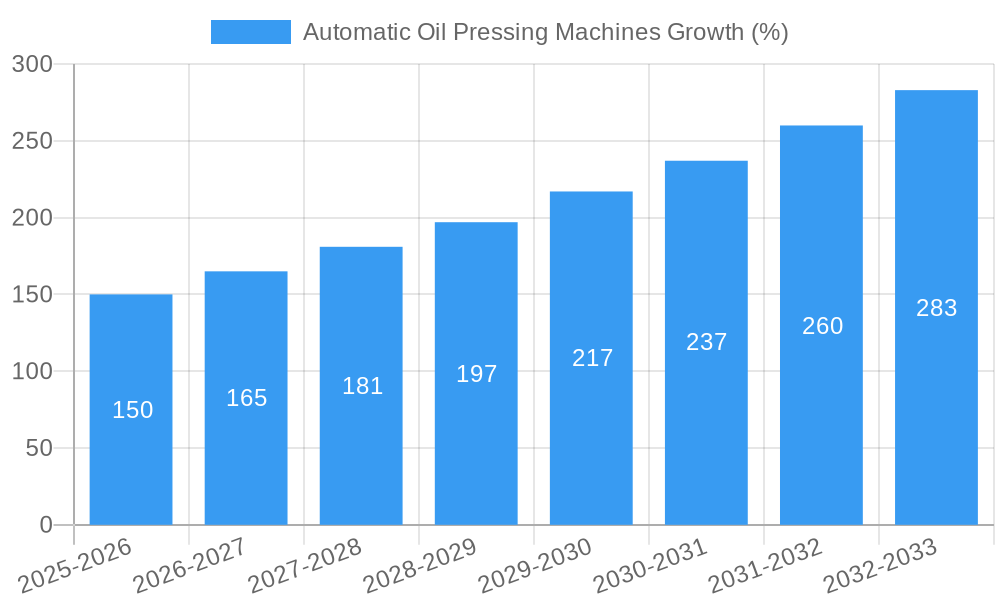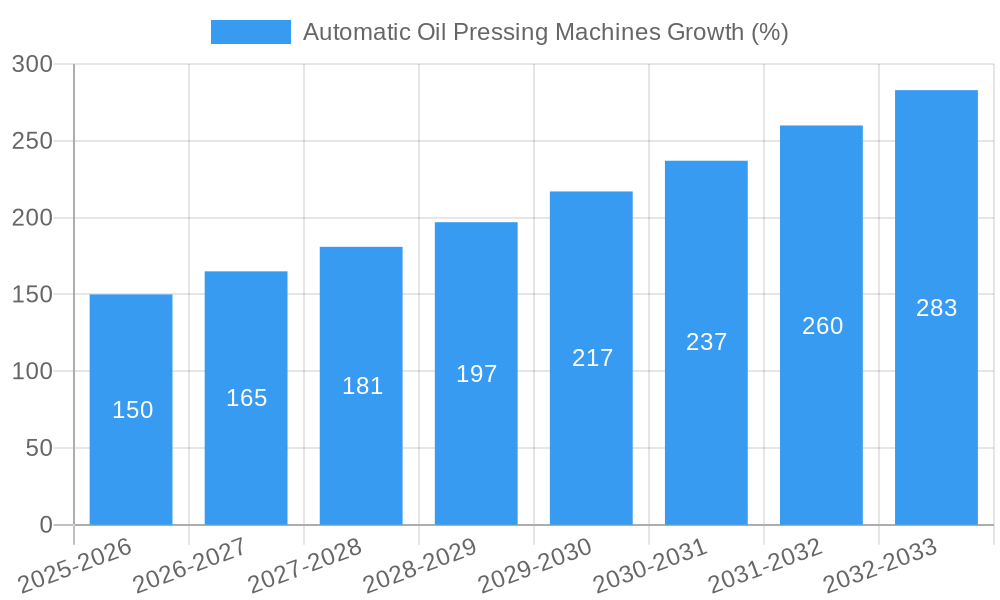Datetime: 2025-08-19 08:23:46 Visit: 9161
Key Insights
The global market for automatic oil pressing machines is experiencing robust growth, driven by increasing demand for healthier cooking oils and rising consumer awareness of the benefits of natural, minimally processed foods. The market's expansion is fueled by several factors, including the growing popularity of plant-based diets, increased adoption of automation in food processing industries, and a continuous need for efficient and cost-effective oil extraction methods. Technological advancements, such as the introduction of advanced screw presses and expellers, are further enhancing the efficiency and yield of these machines, contributing to their widespread adoption across various sectors, from small-scale businesses to large-scale industrial operations. Furthermore, the growing emphasis on sustainable and eco-friendly oil extraction processes is creating new opportunities for manufacturers of automatic oil pressing machines. While challenges such as initial investment costs and the need for skilled operators persist, the long-term benefits of automation, including increased productivity and reduced labor costs, are making these machines increasingly attractive. This positive trend is likely to continue through 2033.
The competitive landscape is marked by a mix of established players and emerging companies, each vying for market share through product innovation, strategic partnerships, and geographic expansion. Key players are investing heavily in research and development to improve the efficiency, automation, and sustainability of their products. This includes exploring new materials, refining designs, and integrating advanced control systems. Regional variations in market growth are anticipated, with developing economies exhibiting higher growth rates driven by rising disposable incomes and increasing industrialization. However, developed economies continue to contribute significantly to the overall market size, particularly in niche applications such as the production of specialty oils and high-value oilseed processing. The ongoing focus on food safety and quality standards will also be a key factor shaping the future of this dynamic market.

Automatic Oil Pressing Machines Concentration & Characteristics
The global automatic oil pressing machines market, valued at several million units in 2025, exhibits a moderately concentrated landscape. Key players, including NATIONAL ENGINEERING, EPS Group, and GOREK TECHNOLOGIES, hold significant market share, although a large number of smaller regional players also contribute. Innovation in this sector focuses on increasing efficiency (higher oil yield, reduced processing time), enhancing automation (reducing labor costs and improving consistency), and incorporating advanced materials for durability and longevity. Regulations concerning food safety and environmental impact (waste oil management) are increasingly influencing machine design and manufacturing processes. Product substitutes, primarily traditional methods of oil extraction, are limited due to the significant advantages offered by automatic pressing machines in terms of scalability, efficiency, and consistency. End-user concentration is seen across diverse sectors, including food processing, biofuel production, and cosmetic manufacturing. The level of mergers and acquisitions (M&A) activity has been moderate in recent years, with larger companies occasionally acquiring smaller specialized manufacturers to broaden their product portfolios or gain access to new technologies.
Automatic Oil Pressing Machines Trends
The automatic oil pressing machines market is experiencing robust growth, driven by factors such as the rising global demand for vegetable oils, increasing adoption of automation in the food processing industry, and the growing biofuel sector. The historical period (2019-2024) showed a steady increase in market size, a trend projected to continue through the forecast period (2025-2033). XXX analysis reveals key insights, highlighting the escalating preference for automated systems among large-scale oil extraction facilities. This shift is fueled by the need for higher productivity, improved product quality, and reduced operational costs. Furthermore, advancements in machine learning and artificial intelligence (AI) are starting to be integrated into automatic oil pressing machines, resulting in enhanced process optimization, predictive maintenance, and real-time quality control. This innovation improves efficiency and minimizes downtime, leading to substantial cost savings for businesses. The growing awareness of health benefits associated with various vegetable oils, coupled with the increasing demand for sustainable and eco-friendly oil extraction methods, is also positively impacting market growth. The preference for automated systems is especially evident in regions experiencing rapid economic growth and industrialization, where the need for large-scale, efficient production is paramount. The increasing popularity of cold-pressed oils, a process readily achievable with advanced automatic machines, further fuels market demand.

Key Region or Country & Segment to Dominate the Market
The food processing segment, driven by the need for large-scale oil extraction for various food applications, is expected to hold a dominant position. This sector requires robust and highly automated systems capable of handling large volumes of oilseeds while maintaining high oil yield and quality. The continuous increase in demand for various vegetable oils in the food and beverage industry is a critical driver for the segment's market dominance. Furthermore, technological advancements enabling improved oil quality and yield further encourage the adoption of automated oil pressing machines within the food processing sector. Increased regulations and consumer preference for high-quality, sustainably sourced oils also play a crucial role.
Automatic Oil Pressing Machines Product Insights
Automatic oil pressing machines are available in a wide range of capacities, configurations, and automation levels, catering to diverse customer needs. Factors like oilseed type, desired oil yield, and production scale influence machine selection. Many machines offer features such as automated seed feeding, temperature control systems, and oil filtration systems. Advancements in materials science result in more durable and energy-efficient designs. The market also witnesses the emergence of compact, easily deployable models ideal for small-scale operations.
Report Coverage & Deliverables
The report segments the market by various factors:
Driving Forces: What's Propelling the Automatic Oil Pressing Machines
Challenges and Restraints in Automatic Oil Pressing Machines
Emerging Trends in Automatic Oil Pressing Machines

Growth Catalysts in Automatic Oil Pressing Machines Industry
The rising global demand for vegetable oils coupled with the expanding biofuel industry are significant catalysts. Technological improvements in automation and sustainability initiatives also fuel market expansion. Increasing consumer preference for health-conscious food choices and the growing focus on reducing food waste further contribute to the industry's growth trajectory. Government initiatives promoting sustainable agriculture and biofuel production also play a crucial role in market expansion.
